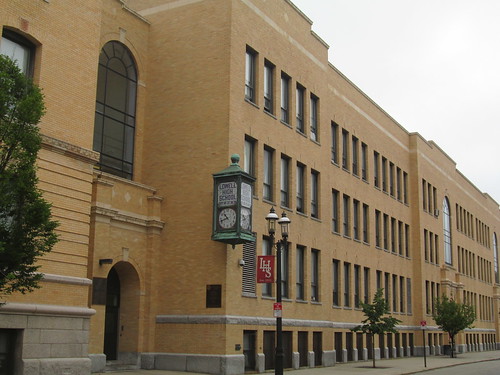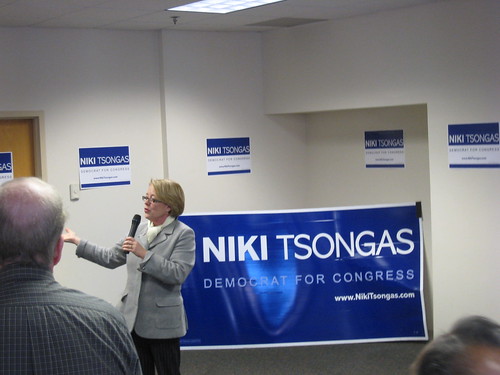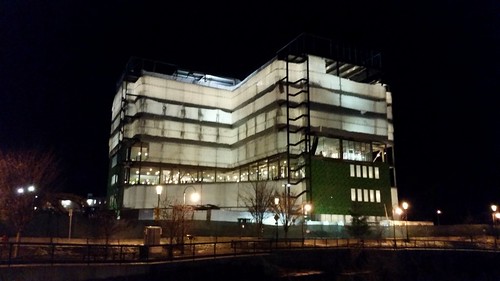Lowell Year in Review: 2017

Lowell High School – Future Location
Cawley or Downtown? Like weekly episodes of a dramatic television miniseries, that was the question that confronted the people of Lowell throughout 2017. The process was slow to start, but then one group of residents mobilized a vigorous campaign to build an entirely new school at Cawley Stadium, and another emerged to advocate keeping the school in downtown. After many public hearings and nearly one hundred motions, on June 20, 2017, the city council voted for the Cawley Stadium option by a five to four margin with Councilors Dan Rourke, Rita Mercier, Rodney Elliott, Corey Belanger and Jim Leary voting for Cawley, and Mayor Kennedy and Councilors Bill Samaras, Jim Milinazzo, and John Leahy voting to keep the school downtown.
Almost immediately, the pro-downtown citizen’s group began a petition drive to put a question about the future location of the high school on the November 2017 city election ballot. Also in the summer, the Lowell School Committee (a majority of whom supported the downtown option) filed a lawsuit against the city council and the city manager in Middlesex Superior Court requesting a declaratory judgment that it was the school committee not the city council that had the authority to select the site for the school.
Before the judge issued his ruling in favor of the council and against the school committee, Massachusetts School Building Authority’s Board of Directors, at tis August meeting, continued the Lowell High matter indefinitely, with one MSBA member urging city representatives to come back after the “internal strife” over the location decision was resolved.
While the election outcome did not end the internal strife, it did provide results that were decisively in favor of keeping the high school downtown. At the December 2017 MSBA meeting, city representatives received instructions on how to replace the original Cawley submission with a new one for a downtown high school. But with multiple options available for downtown, the exact path to be followed remains unclear.
City Election
The Massachusetts School Building Authority’s August continuance focused all attention on the city election. All candidates for council and school committee clearly stated their LHS site preference and the outcome of the election seemed to turn entirely on that issue. On the council, the 5 to 4 pro-Cawley majority changed to a 7 to 2 pro-downtown super majority with pro-downtown incumbents Ed Kennedy, Bill Samaras, Jim Milinazzo (who had earlier announced he would not run but then reversed that decision) and John Leahy winning reelection. They will be joined by newly elected, pro-downtown councilors Vesna Nuon (who finished first), Dave Conway and Karen Cirillo. Rounding out the new council will be pro-Cawley incumbents Rita Mercier and Rodney Elliott. The three incumbents who lost – Jim Leary, Corey Belanger and Dan Rourke – all were Cawley supporters.
While a majority of the school committee had favored downtown, the election strengthened that position with pro-downtown newcomers Dominik Lay and Gerry Nutter joining pro-downtown incumbents Jackie Doherty, Connie Martin and Bob Hoey. Incumbent Andy Descoteaux was the only Cawley supporter to make it on to the new school committee. Pro-Cawley incumbent Robert Gignac ran unsuccessfully for the city council and pro-downtown incumbent Steve Gendron did not seek reelection.
The referendum question, which asked “The city of Lowell is reviewing several options for its high school project. Do you support extensive renovation and rebuild at the existing Lowell High School location, at 50 Father Morissette Boulevard, Lowell, MA 01852?” received 7,254 Yes votes to 4,629 No votes, with the Yes side winning in 29 of the city’s 33 precincts.

Niki Tsongas Will Not Seek Re-election
In August, Congresswomen Niki Tsongas announced that she would not seek reelection in 2018. Tsongas, who won the seat in a 2007 special election, replaced Marty Meehan as this region’s Representative in Congress. Candidates to succeed Tsongas include, on the Democratic side, Alexandra Chandler, Abhijit “Beej” Das, Rufus Gifford, Steve Kerrigan, Dan Koh, Barbara L’Italien, Patrick Littlefield, Bopha Malone, Juana Matias, Nadeem Mazen, Terry Ryan and Lori Trahan. On the Republican side, Rick Green may be the sole candidate at this point.
Voting Rights Lawsuit
In May, thirteen Lowell residents filed suit against the city in the U.S. District Court, alleging that the city’s at large system of electing city councilors and school committee members diluted the votes of members of ethnic and racial minority groups and was therefore in violation of the Federal Voting Rights Act. The case is still pending, having survived the city’s motion to dismiss.
Two weeks after this lawsuit was filed, the city council, on a joint motion by Councilors Rodney Elliott, Jim Leary and Bill Samaras, created a subcommittee to make recommendations on possible changes to the city’s charter regarding the method of electing councilors. This subcommittee held several public meetings during 2017 and its work will presumably continue in 2018.

Development Developments
Each year brings new buildings, bridges, road alignments and other changes to the city’s built environment. Perhaps the most visible of these in 2017 was the Lowell Judicial Center which rapidly rose to its full seven story height, Set on the edge of the Hamilton Canal District, the Judicial Center dominates the skyline from many spots in the city and is ahead of schedule with a planned opening in the summer of 2019.
Although there was little visible progress within the rest of the Hamilton Canal District, and the city lost its second master developer when it parted ways with Winn Companies in January, there was some conceptual progress, at least, on a number of fronts. Despite its withdrawal as master developer, Winn will stay involved in the Hamilton Canal District with the city council authorizing the transfer of two parcels to the company for the construction of adjacent apartment buildings alongside the Pawtucket Canal. Similarly, S&R Corporation has entered into an agreement with the city to construct a 40,000 square foot office building with ground floor retail across the street from the UMass Lowell Innovation Hub at 110 Canal Place (which is now filled and thriving). Sal Lupoli in partnership with David Heller (owner of the Lowell Spinners), is contemplating the construction of a 20 story mixed use building across Jackson Street from the Judicial Center. And Watermark still plans to construct a 70,000 square foot office building on the Dutton Street side of the HCD at the split of the Merrimack and Pawtucket Canals.
Other “on the drawing board” projects include the design of a 900-space municipal parking garage on the Market Street side of the HCD, and progress continues to be made with the “land swap” between the city and the federal government for the transfer to the city of the surface parking lot now used for Lowell National Park visitors. The new “satellite bus parking area” near the Gallagher Terminal, one of the pre-conditions of the swap, is nearing completion, but another pre-condition – having a place to park visitor cars – awaits completion of the new garage.
Otherwise, in January, the city council unanimously adopted the plan to “fill in” the Lord Overpass, converting that complex intersection back to a single level. The main driver of this plan is to make the Judicial Center accessible to those coming from the Lowell Connector, but it is hoped that the plan will make the current Overpass area safer and more convenient for walkers and those on bicycles. This is also in the design stage. A portion of this project that will happen sooner that the Overpass itself will reconfigure the entrance to the Lowell Connector from Thorndike Street and the intersection of Thorndike and Highland Street.
In the same neighborhood, the Lupoli Company’s conversion of the Thorndike Factory Outlet into a big, mixed-use development with apartments, retail and restaurants is nearing completion. Just across Thorndike Street from that, the city in 2017 unveiled a number of improvements to the South Common including 1500 feet of new multiuse trails with new trees and lights. Lights have also been added to the Common’s large athletic field.
Elsewhere, Edge Merrimack River opened its “private dormitory” across from Lowell High. Another private dormitory proposal, this one on the former Jeanne d’Arc Credit Union site at Merrimack and Cabot, was withdrawn before it could be rejected, however, a variant of the proposal is expected to reemerge in 2018.
Also in 2017, the former Franco-American School at Pawtucket and School Streets was sold to a group that included Coalition for a Better Acre and developer Brian McGowan.
Obstacles
Traffic remained a chronic problem in 2017, especially at the bridges across the Merrimack River. Speaking of bridges, the one across the Pawtucket Canal at Broadway just opened this week, I’m told, after more than a year of repairs. Another bridge, this one over the Western Canal on Market Street, closed midway through this year. These are two of the bridges owned by Enel (and formerly by Locks and Canals Corporation) that the city hopes to own in the near future. Still, having major roads blocked just adds to traffic problems. There was some positive traffic-related news: UMass Lowell and the Lowell Regional Transit Authority finally entered into a partnership that makes it easier for UML students and staff to use public transportation and the LRTA has added a small fleet of Zipcars to the Gallagher Terminal.
The city had some success in strategies that addressed the ongoing opioid epidemic but that plague continues, Other strategies for addressing substance abuse-related issues, especially at some of the downtown public spaces like Kerouac and Lucy Larcom Parks, remained elusive.
For two days in May, Lowell was in the headlines as the site of an intense manhunt in the Highlands neighborhood. After murdering his estranged girlfriend, the suspect disappeared. A massive police response blocked streets and ordered residents to stay indoors. The manhunt ended when the suspect was discovered dead from a self-inflicted wound in the trunk of a car a day later.
Festival City
Lowell’s roster of festivals grew this year with Creaticity, a new two-day “arts and maker festival on Market Street in September. This joined the Lowell Kinetic Sculpture Race, Winterfest, the Southeast Asian Water Festival, and many other downtown and riverfront weekend festivals that occur throughout the year. The Lowell Folk Festival had another successful year, with this year’s evolution being the movement of food vendors from JFK Plaza to adjacent Arcand Drive.
An exciting new event occurred in April. The Points of Light Lantern Celebration, organized by the community based group, DIY Lowell in conjunction with the city, the National Park, and many other partners, was a huge success. Held at Ecumenical Plaza which spans the Western Canal from St. Patrick’s to Holy Trinity Churches, the celebration featured music, ethnic food, and more than a thousand individually decorated and illuminated lanterns that were launched into the canal at dusk.
A big part of the Points of Light celebration was the illumination of the facades of the two churches by the Lowell Heritage Partnership’s Waterways Vitality Initiative which had previously lit up the Merrimack Canal along Lucy Larcom Park and the Swamp Locks in the middle of the Hamilton Canal District. The good work of the Waterways Vitality Initiative project will continue in 2018, aided by a grant of $100,000 from the Parker Foundation which will be used along with extremely generous private donations, to light up the Cox (Bridge Street) Bridge in 2018.
Lowell Walks had another successful summer of guided walking tours, with more than 1100 people participating. Here are the tours, tour guides, and attendance for 2017:
Jun 10 – Western Canal with Dick Howe – 150 walkers
Jun 17 – Abolitionism & Underground Railroad with Bob Forrant – 226 walkers
Jun 24 – Churches of Lowell with Dave McKean & Rosemary Noon – 111 walkers
Jul 8 – Lowell Poems & Poets with Paul Marion – 84 walkers
Jul 15 – Kerouac Downtown with Sean Thibodeau & Rober Brunelle – 96
Jul 22 – Lowell Fires with Jason Strunk – 98
Aug 5 – Urban Renewal with Chris Hayes & Aurora Erickson – 90
Aug 12 – Hamilton Canal District with Claire Ricker of DPD – 110
Aug 19 – Public Health with Sue Levine & Clare Gunther – 50
Aug 26 – Mill Girls of Lowell with Tess Shatzer of LNHP – 105
Also this year, Paul Marion released his new book, Union River, on May 3 at Mill No. 5’s Luna Theatre at a benefit in support of the Public Matters program. In August, Paul and I released History as It Happens: Citizen Bloggers in Lowell, Mass., which compiled the best blog posts from this site by 40 different contributors from 2007 through 2016.
In sports, congratulations to the UMass Lowell River Hawks men’s hockey team for winning the Hockey East championship, and to the New England Patriots for winning the Super Bowl.
Finally, thanks to everyone who reads, comments upon, and contributes to this site. As I wrote in the introduction of History as It Happens, blogging is a never-ending community-based social experiment. Thanks for being – and continuing to be – partners in that effort.
Happy New Year!
Thanks, Jim. Same to you and to everyone else.
Happy New Year, Dick. Thanks for the recap.
Than you for your Blog, it is how I stay updated in Lowell. Real news.
Looking forward to reading many more postings. Happy New Year!
Richardhowe.com is truly a civic gem. Thank you to Dick & the contributors for all the work that goes in to this.
Happy new year Lowell
Dick, in a very recent meeting that I attended regarding the Lowell Judicial Center I learned that the new city garage would not be opening when the judicial center opens in June 2109 or earlier. There was a further concern that the city may not be able to issue bonds to fund the construction because the new high school costs would exceed the city bonding capacity. I welcome any new information you may have concerning the judicial center. thanks
Happy New Year!
I’ve only heard that the Judicial Center is on track to open in summer 2019. I’ve not heard anymore about parking other than the 900-space Hamilton Canal District garage that will be closer to Market Street, and it doesn’t look like that will be up and completed by the time the courthouse opens. Add to that the Lord Overpass reconstruction getting underway, and it’s pretty clear that traffic and parking will be a big issue 18 months from now.
One way to free up spots in the garages is to institute a parking cash out policy for all public and private employees that use the garages.
Pay them what is being paid to park to reward them for walking, biking, or taking the bus to work. It will encourage people to live in or close to downtown as well.
More on-street parking should be allowed on Jackson St and pricing needs to carefully updated as well.
Saying we need more garages ignores sensible actions that should be taken before we spend 20 + million on another congestion inducing garage.
Brian,
Thank you! I like your idea for the “parking cash out policy”. When I lived in Chicago, my father used to give us money to take the el and bus to get to school. I would normally save money by walking to the el stop instead of riding the bus or even walking all the way to school. This way I had extra money to spend on toys, movies, candy, or whatever else I wanted. Your suggestion gives more choice and control to individuals and allows for more elasticity in respects to transportation problems. This choice promotes workers to make choices that fit their situation and hopefully also help the environment for all.